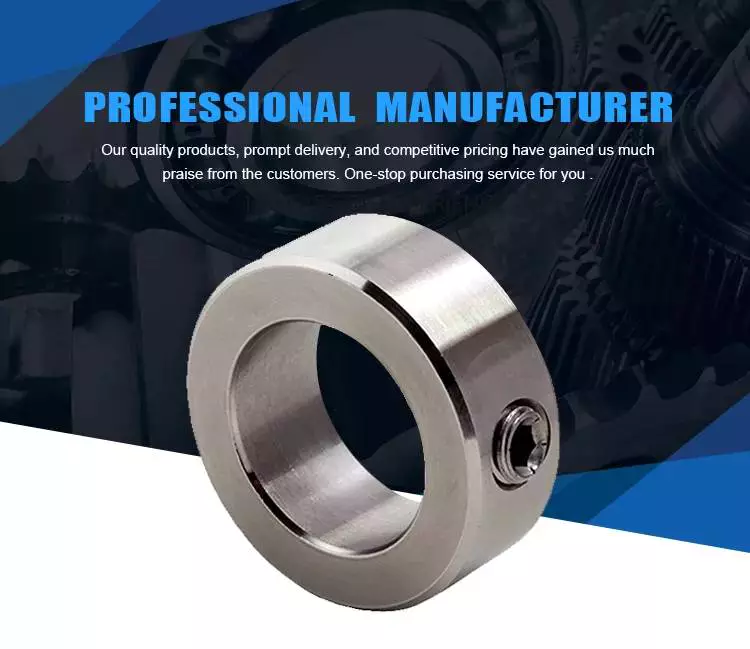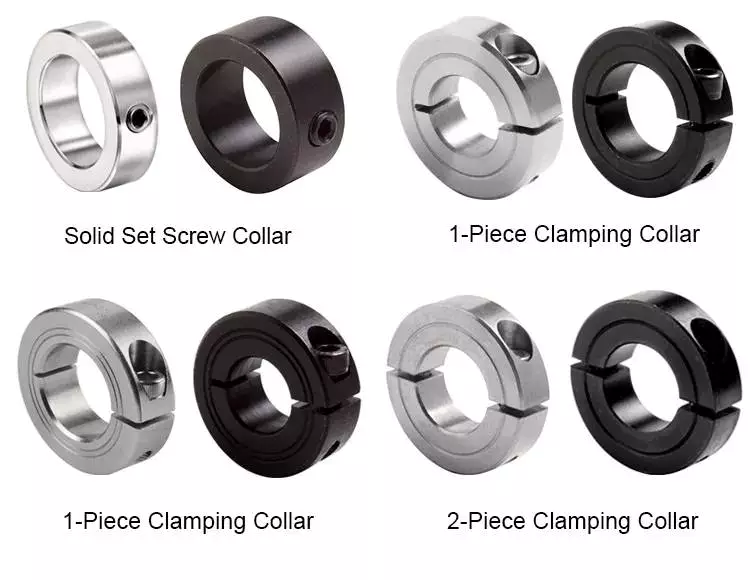
What are the temperature and corrosion resistance properties of shaft collars?
The temperature and corrosion resistance properties of shaft collars vary depending on the materials they are made of. Different materials exhibit different levels of resistance to temperature extremes and corrosion. Here are some commonly used materials for shaft collars and their temperature and corrosion resistance properties:
- Steel: Steel shaft collars, particularly those made from stainless steel, offer excellent temperature and corrosion resistance properties. Stainless steel is known for its high strength, durability, and resistance to rust and corrosion. It can withstand a wide range of temperatures, from low cryogenic temperatures to high heat environments. Stainless steel shaft collars are often used in applications where exposure to moisture, chemicals, or harsh environments is a concern.
- Aluminum: Aluminum shaft collars have good temperature resistance properties and can handle moderate temperature ranges. They are lightweight and offer reasonable corrosion resistance. However, aluminum is not as corrosion-resistant as stainless steel and may be susceptible to certain chemicals or highly corrosive environments. Aluminum shaft collars are commonly used in applications where weight reduction is a priority, such as aerospace or automotive industries.
- Plastic: Plastic shaft collars, such as those made from nylon or acetal, have limited temperature resistance compared to steel or aluminum. They can typically handle moderate temperatures but may deform or degrade at higher temperatures. Plastic collars are not as resistant to corrosion as metal collars but can still offer good resistance to certain chemicals and environmental conditions. Plastic collars are often used in applications where weight, cost, or electrical insulation properties are important factors.
- Brass: Brass shaft collars offer good temperature resistance and moderate corrosion resistance. They can handle a range of temperatures and are often used in applications where a combination of durability, conductivity, and aesthetics is required. Brass collars may tarnish over time but can still maintain their functionality and structural integrity.
It is important to note that the temperature and corrosion resistance properties of shaft collars can also be influenced by factors such as the specific alloy composition, surface treatments, and environmental conditions they are exposed to. When selecting shaft collars for your application, it is crucial to consider the temperature range and potential exposure to corrosive substances or environments. Consulting with manufacturers, reviewing technical specifications, and considering industry standards or guidelines can help ensure that you choose shaft collars with appropriate temperature and corrosion resistance properties for your specific needs.

Are there specific shaft collars designed for use in high-speed applications?
Yes, there are specific shaft collars designed for use in high-speed applications. High-speed applications require shaft collars that can withstand the rotational forces and vibrations associated with high speeds while maintaining secure and reliable shaft connections. Here are some considerations and features of shaft collars designed for high-speed applications:
- Balanced Design: Shaft collars designed for high-speed applications are often engineered with a balanced design to minimize the potential for imbalance and vibration at high rotational speeds. This helps ensure smooth operation and reduces the risk of damage to the collar, shaft, or associated components.
- High-Quality Materials: High-speed shaft collars are typically made from high-quality materials that offer excellent strength, durability, and resistance to wear. Common materials used include steel, stainless steel, or other alloys known for their mechanical properties and ability to withstand high-speed conditions.
- Precision Machining: To maintain the necessary balance and minimize potential runout, high-speed shaft collars undergo precise machining processes. This ensures that the collar has consistent dimensions, smooth surfaces, and accurate alignment for optimal performance at high speeds.
- Secure Clamping Mechanism: High-speed shaft collars often incorporate advanced clamping mechanisms to provide a secure and reliable grip on the shaft. These mechanisms, such as precision-machined set screws, high-strength clamping levers, or quick-release clamping systems, help prevent slippage or movement of the collar on the shaft during high-speed operation.
- Specialized Coatings or Treatments: Some high-speed shaft collars may feature specialized coatings or treatments to enhance their performance. For example, certain collars may have coatings that reduce friction or improve wear resistance, while others may undergo heat treatments or surface hardening processes to increase their strength and durability under high-speed conditions.
- Compliance with Standards: In some industries or applications, specific standards or regulations may exist for high-speed rotating equipment. Shaft collars designed for such applications may be manufactured to comply with these standards, ensuring that they meet the necessary performance and safety requirements for high-speed operation.
When selecting shaft collars for high-speed applications, it is important to consider factors such as the required speed range, load capacity, environmental conditions, and any specific industry or application standards. Consulting with manufacturers or industry experts can provide valuable guidance in choosing the most suitable shaft collars that meet the demands of your high-speed application.

What is a shaft collar and its role in mechanical systems?
A shaft collar is a mechanical component used in various applications to provide support, positioning, and locking functions for rotating shafts. It is a cylindrical device that fits around a shaft and is typically secured in place using set screws or clamping mechanisms. The collar is designed to prevent axial movement of the shaft and maintain its position within a mechanical system. Here is a detailed explanation of the role and significance of shaft collars in mechanical systems:
Support and Positioning:
One of the primary roles of a shaft collar is to provide support and positioning for a shaft within a mechanical system. It acts as a physical barrier that prevents the shaft from moving along its axial direction. By securing the collar at a specific location along the shaft, it helps maintain the desired position of the shaft relative to other components, such as bearings, gears, or pulleys. This support and positioning function ensures proper alignment and operation of the system, preventing unwanted vibrations, misalignment, or excessive wear.
Axial Load Distribution:
Shaft collars also help distribute axial loads along the length of the shaft. When a mechanical system experiences axial forces or thrust, the collar can help transmit and distribute these forces to the supporting components, such as bearings or thrust washers. By evenly distributing the load, shaft collars help prevent localized stress concentrations and improve the overall load-bearing capacity of the system.
Limiting Radial Movement:
In addition to preventing axial movement, shaft collars can also limit radial movement of the shaft within a given range. The collar's design and tight fit around the shaft create a mechanical barrier that restricts radial play or shifting of the shaft. This is particularly important in applications where precise positioning or clearance control is required, such as in linear motion systems, conveyor systems, or machinery with rotating components.
Securing Components:
Shaft collars often serve as a means of securing other components onto the shaft. They can act as a stopping point or reference surface against which other elements, such as bearings, sprockets, gears, or pulleys, can be mounted. By securing these components with set screws or clamping mechanisms, shaft collars ensure their proper alignment and prevent unintentional movement or disengagement during operation.
Adjustability and Easy Installation:
Another advantage of shaft collars is their adjustability and ease of installation. They can be easily positioned and moved along the shaft without requiring complex tools or specialized equipment. This adjustability allows for fine-tuning of the shaft's position and alignment within the system. Additionally, the simplicity of their design and installation makes shaft collars a cost-effective solution for various mechanical applications.
Overall, shaft collars play a significant role in mechanical systems by providing support, positioning, load distribution, and component securing functions. Their presence helps ensure the stability, alignment, and efficient operation of rotating shafts in diverse applications across industries such as manufacturing, automation, robotics, and machinery.


editor by CX 2023-12-08